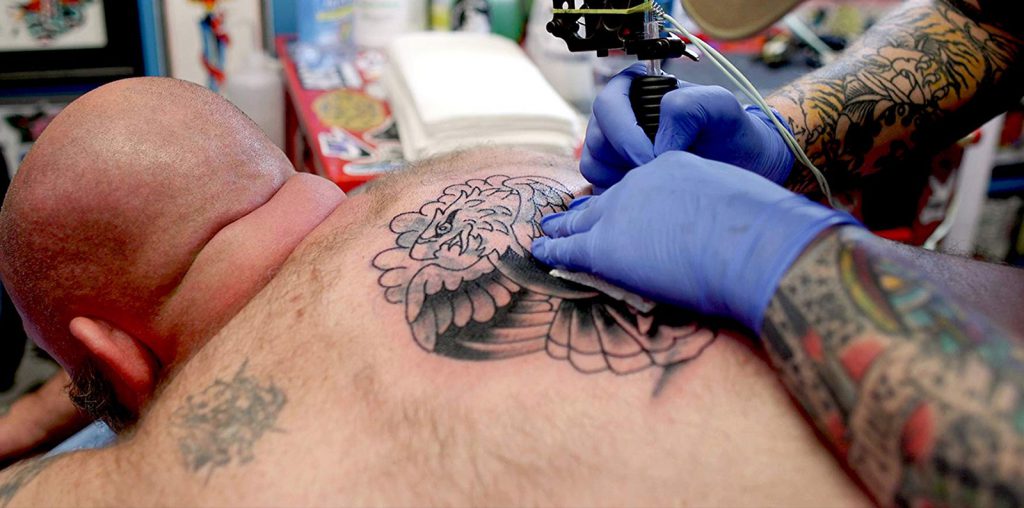“Bring me your mistakes.”
In 2018’s Beneath the Ink, director Cy Dodsen films tattoo artist Billy Joe White and his Red Rose Tattoo Studio in Southeastern Ohio, sharing their story of “erasing the hate” that has seemed to envelope Zanesville, Ohio–and the world–in the last few years. Intimate interviews, an efficient narrative structure, and smooth, realistic editing take Beneath the Ink further than just skin-deep.

Tattoo artist Billy White working on one of the tattoos in the film.
What’s most striking about this documentary, besides its sensitive topic and artistic endeavors, is the time-stamp. A documentary of only 12 minutes, Beneath the Ink says more in those minutes than some films do in the traditional hour-and-a-half. Carrying viewers from start to finish with voice-over narration, face-to-face interviews and location footage, director Cy Dodson reveals to the big-screen Billy White’s mission and who he is as a person, offering something that can be hard to find in this day and age: empathy. The film’s topics are sensitive, violent, unnerving, and brutally honest. The film asks viewers to face the eternal questions of “How do you find it within yourself to forgive?” and “How do you forgive something that is seemingly fueled by hate?”
The documentary begins with images of a relatively small and barren town with construction tearing down remaining buildings to nothing but rubble and brick, run-down vehicles off to the sides of roads and a man rummaging through abandoned items. Over these images, viewers hear Billy White’s voice: “You see it every day… and socially speaking, when you’re not helping society move forward, you’re bound to see it crumble.” This voice-over while the camera pans across still, giant claw-machines hovering over torn-down structures completely sets the mood for the remaining minutes. It is within these beginning shots and voice-overs that I had to sit back and think “Wow. I’m getting into something a lot deeper than just tattoos.” The camera shots flowing from up-close, personal views, back out to widescreen shots that show the mass of torn down buildings allow viewers to get into the mindset of this town and the topics that are going to be discussed. White’s voice, mixed over shots of muted-colored surroundings of a town deteriorating just like people’s faith in one another, sets the tone.

Billy White working in the film.
White and the artists at Red Rose have made waves across the nation with their mission to “erase the hate”, doing cover-ups of what can be viewed as offensive and/or racist tattoos–all for free. In the film, two people are interviewed on their hate-tattoos and viewers get to see three cover-ups from start to finish: A geometric flower tattooed over a swastika on a woman’s foot, a dragon placed over a swastika on a man’s chest, and a large, gorgeous bird tattooed over a depiction of a Ku Klux Klan member standing in front of a burning cross on the center of a man’s back.

One of the tattoo transformations.
As each interview of clients commences, their stories reveal what a person’s mindset can be like to put something so permanent on display, and how life can lead down so many different paths. These interviews employ zoomed-in framing as each person continues their story, both of which can be interpreted as influencing viewers–as documentary film typically aims to do–to empathize with the people and stories they’re hearing. As viewers get to know the two interviewees and learn their reasoning behind each hate-tattoo, while also seeing them come to terms with and cover up those parts of their pasts, empathy and forgiveness arises.
Besides the cinematic content and interview subjects, Beneath the Ink is tightly edited. Seamlessly flowing along and building character as it goes on make the film’s impact last a lot longer than just 12 minutes, as the film employs an editing style that depicts a “normal” environment for such intense and awe-inducing work. It is a beautiful paradox to create. Shots that are mainly in the foreground and middle ground range create a more personal and serious atmosphere in film which bodes well for Beneath the Ink alongside editing to fit each shot’s emotion; Fading in and out for “dramatic” moments such as revealing the first swastika tattoo, choosing to include the easy-going greetings between White and clients despite the hate-tattoos revealed, and shots of each tattoo transformation and an emphasis on the tattoo gun keep the paradoxical editing effect going. The style allows viewers to be eased into each new story and each image displayed while also shining light on the darkest of topics in a way that’s easy to understand and follow along.
White concludes in the beginning half of the film that “we’re reverting back into a time that I thought we had moved past”, and whether or not that is true is of our society is up for individual reflection and debate. But, Beneath the Ink does reveal something out-right: people are capable of growth and change if simply given the smallest contribution of empathy, like getting the chance to cover up a mistake of the past.
Winner of 12 awards at several film festivals for Best Documentary, Audience Award, Best Short, etc. in various places including Minneapolis, Palm Springs, New York City, Los Angeles, and others have proven the documentary has struck a chord with the public. Qualifying for the 2019 Academy Awards, the impact that Billy White and fellow tattoo artists at Red Rose have had has transformed into so much more than even director Cy Dodson could have imagined. Perhaps “erasing the hate” has begun to work after all.
The trailer for Beneath the Ink (don’t worry, it doesn’t give too much away).


Recent Comments